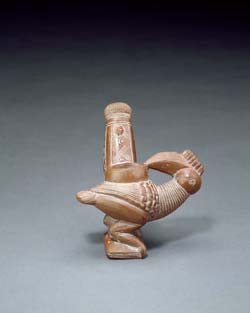
The ability of the bird to fly makes it a symbol of communication with the spirit world. As represented in art, it may be from a specific species, a composite of several birds or draw on common attributes. Is it active during the day or night? Is it domestic or wild? male or female? hunter or prey?
Among the Yoruba peoples, the bird's association with the other world is not necessarily all good--if it is a bird of the night, it may be summoned by persons motivated by envy and malice. The depiction of birds flocking around one bird represents the rulers and healers taking control over these potentially dangerous forces for the good of the community (acc. no. 75-15-17).
Their calls can also be important. A bird overhead as Oba Esigie of the Benin kingdom was going to war around 1550 sounded as if it cried "disaster!" whereupon the chiefs wanted to turn back. The king commanded his men to kill the bird. After winning the battle, the king ordered gongs cast for the chiefs so that his court would always remember that while ordinary people lose, the Oba of Benin triumphs over Fate itself. The bird's long beak refers to its ability to speak and not its actual appearance (Collection of Olga Hirshhorn).
 The pose of a bird looking backwards, a common enough action in nature, is one of the more popular symbols--known as the sankofa bird (acc. no. 75-22-310)--among the Akan peoples. The word sankofa is loosely translated as "go back and fetch it," suggesting that one should learn from the past as a way to move forward into the future. The pose of a bird looking backwards, a common enough action in nature, is one of the more popular symbols--known as the sankofa bird (acc. no. 75-22-310)--among the Akan peoples. The word sankofa is loosely translated as "go back and fetch it," suggesting that one should learn from the past as a way to move forward into the future.

Sankofa bird pipe bowl
Asante peoples, Ghana
19th century
Ceramic
Acquisition grant from the James Smithson Society,
89-8-24
|

Herbalist's staff
Yoruba peoples, Nigeria
Mid-20th century
Iron
Gift of Herbert Baker,
71-15-17
|
|
|
|